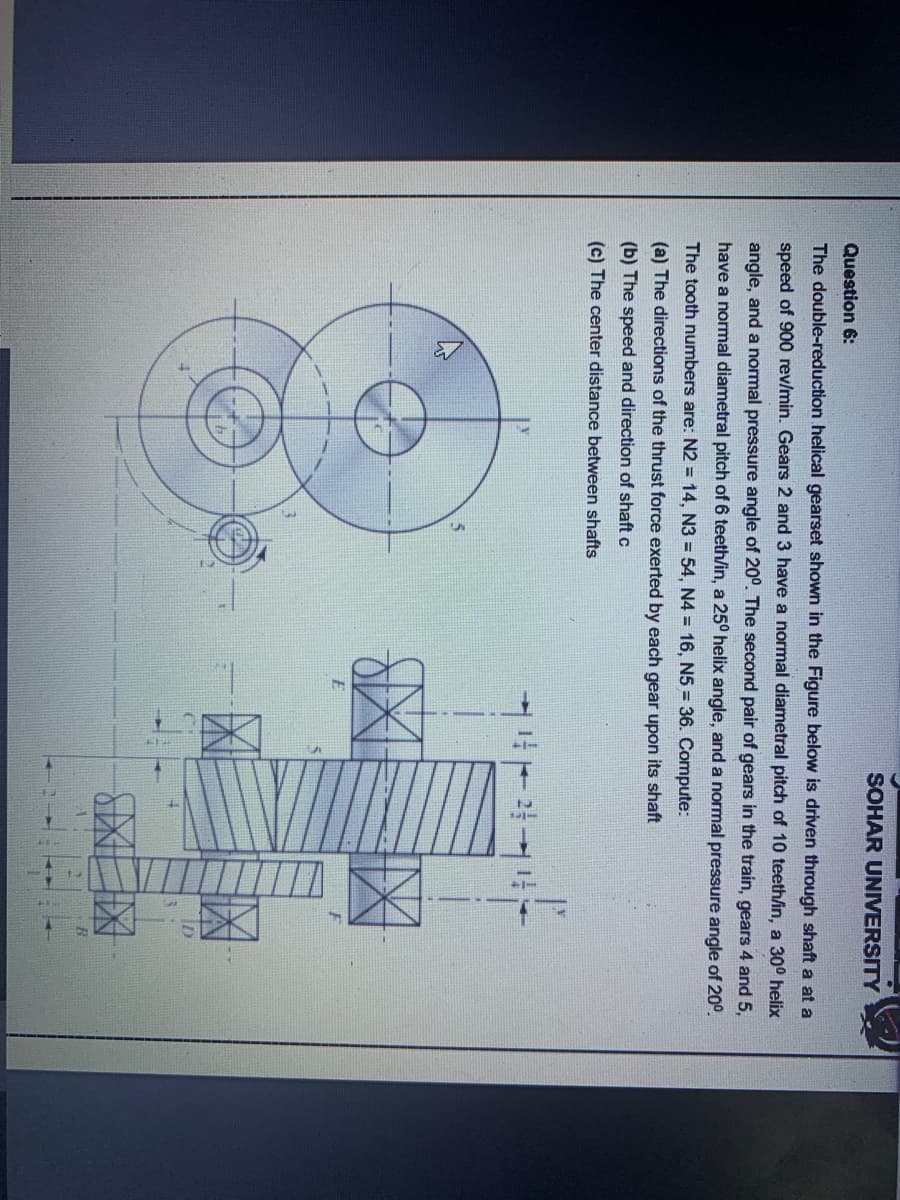14 The double-reduction helical gearset shown in the Figure below is driven through shaft a at a speed of 900 rev/min. Gears 2 and 3 have a normal diametral pitch of 10 teeth/in, a 30° helix angle, and a normal pressure angle of 20°. The second pair of gears in the train, gears 4 and 5, have a normal diametral pitch of 6 teeth/in, a 25° helix angle, and a normal pressure angle of 20°. The tooth numbers are: N2 = 14, N3 = 54, N4 = 16, N5 = 36. Compute: %3D (a) The directions of the thrust force exerted by each gear upon its shaft (b) The speed and direction of shaft c (c) The center distance between shafts 5. E.
14 The double-reduction helical gearset shown in the Figure below is driven through shaft a at a speed of 900 rev/min. Gears 2 and 3 have a normal diametral pitch of 10 teeth/in, a 30° helix angle, and a normal pressure angle of 20°. The second pair of gears in the train, gears 4 and 5, have a normal diametral pitch of 6 teeth/in, a 25° helix angle, and a normal pressure angle of 20°. The tooth numbers are: N2 = 14, N3 = 54, N4 = 16, N5 = 36. Compute: %3D (a) The directions of the thrust force exerted by each gear upon its shaft (b) The speed and direction of shaft c (c) The center distance between shafts 5. E.
Elements Of Electromagnetics
7th Edition
ISBN:9780190698614
Author:Sadiku, Matthew N. O.
Publisher:Sadiku, Matthew N. O.
ChapterMA: Math Assessment
Section: Chapter Questions
Problem 1.1MA
Related questions
Question

Transcribed Image Text:SOHAR UNIVERSITY
Question 6:
The double-reduction helical gearset shown in the Figure below is driven through shaft a at a
speed of 900 rev/min. Gears 2 and 3 have a normal diametral pitch of 10 teeth/in, a 30° helix
angle, and a normal pressure angle of 20°. The second pair of gears in the train, gears 4 and 5,
have a normal diametral pitch of 6 teeth/in, a 25° helix angle, and a normal pressure angle of 20°.
The tooth numbers are: N2 = 14, N3 = 54, N4 = 16, N5 = 36. Compute:
(a) The directions of the thrust force exerted by each gear upon its shaft
(b) The speed and direction of shaft c
(c) The center distance between shafts
Expert Solution
This question has been solved!
Explore an expertly crafted, step-by-step solution for a thorough understanding of key concepts.
This is a popular solution!
Trending now
This is a popular solution!
Step by step
Solved in 4 steps with 2 images

Knowledge Booster
Learn more about
Need a deep-dive on the concept behind this application? Look no further. Learn more about this topic, mechanical-engineering and related others by exploring similar questions and additional content below.Recommended textbooks for you

Elements Of Electromagnetics
Mechanical Engineering
ISBN:
9780190698614
Author:
Sadiku, Matthew N. O.
Publisher:
Oxford University Press

Mechanics of Materials (10th Edition)
Mechanical Engineering
ISBN:
9780134319650
Author:
Russell C. Hibbeler
Publisher:
PEARSON

Thermodynamics: An Engineering Approach
Mechanical Engineering
ISBN:
9781259822674
Author:
Yunus A. Cengel Dr., Michael A. Boles
Publisher:
McGraw-Hill Education

Elements Of Electromagnetics
Mechanical Engineering
ISBN:
9780190698614
Author:
Sadiku, Matthew N. O.
Publisher:
Oxford University Press

Mechanics of Materials (10th Edition)
Mechanical Engineering
ISBN:
9780134319650
Author:
Russell C. Hibbeler
Publisher:
PEARSON

Thermodynamics: An Engineering Approach
Mechanical Engineering
ISBN:
9781259822674
Author:
Yunus A. Cengel Dr., Michael A. Boles
Publisher:
McGraw-Hill Education

Control Systems Engineering
Mechanical Engineering
ISBN:
9781118170519
Author:
Norman S. Nise
Publisher:
WILEY

Mechanics of Materials (MindTap Course List)
Mechanical Engineering
ISBN:
9781337093347
Author:
Barry J. Goodno, James M. Gere
Publisher:
Cengage Learning

Engineering Mechanics: Statics
Mechanical Engineering
ISBN:
9781118807330
Author:
James L. Meriam, L. G. Kraige, J. N. Bolton
Publisher:
WILEY